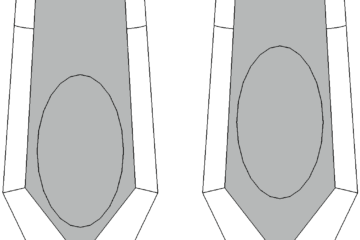Several people have asked for details about the new ultralight 40D ripstop heat sealable fabric available in the shop. At 100 grams per square meter (3 ounces per square yard), it’s very lightweight and packs down very small (similar to a modern tent fly fabric), but it’s surprisingly strong and heat seals very well because it doesn’t melt easily like other lightweight heat sealable fabrics I’ve tried.
It’s obviously not as puncture resistant as the 210D fabric, which is nearly three times the weight, and if there’s significant tension on the 40D a rip will propagate once you get it started in spite of the ripstop grid. That’s normal though… I’ve never met a ripstop fabric that lived up to its name.
I haven’t had a chance to test the tensile strength yet myself, but I do plan to make a new fabric comparison video soon. The manufacturer’s test, done before the TPU was added, indicates a breaking strength of over 400 to 600 Newtons per 50 mm strip – that’s 90 to 130 pounds per two-inch strip, or about 40 to 60 kg per 50 mm. The TPU adds even more strength, so it’s pretty strong in spite of the light weight.
The TPU coating is thinner than TPU on the heavier fabrics, which makes it supple and packable, but it’s still airtight, and heat sealed bonds are very strong. I made a little inflatable pillow to test it and it worked very well; in fact, I think it’s easier to work with than the heavier fabrics because it’s thin and heat conducts through it very quickly, which makes heat sealing a snap.
I like this fabric a lot, and I think it will be great for inflation bags, ultralight seats, ultralight packrafts, and other projects (an ultralight dry suit, tarp, packraft sail, stuff sacks… the list goes on).
The thin threads take dyes very well, too, so the colors look great!

8 Comments
Brad · July 9, 2020 at 8:20 pm
How would this fabric compare to this 4.3 oz./sq. yard 70d heat sealable nylon taffeta? Would this taffetta work for a light packraft? Would there be a significant weight or durability diference?
https://www.seattlefabrics.com/60-Heat-Sealable-Coated-Nylon-Taffeta-1495-linear-yard_p_31.html
Matt (Admin) · July 10, 2020 at 7:37 am
I’m not sure, but regardless, I always recommend purchasing a fabric sample pack so you can compare fabrics directly.
zack · July 21, 2017 at 2:05 am
Is this what the “ultralight kit” features ?
Matt (Admin) · July 21, 2017 at 8:56 am
Yes, that’s right 🙂
Griz · July 20, 2017 at 6:03 pm
The lightest paragliders use Porcher 27gm/m2 (just under one ounce per square meter), and it is zero porosity at least when new.
VERY expensive, and would likely make too fragile of a packraft. But using tapes to give it form, you could probably make an insanely light floating “sopapilla” similar to the Klymit Lightwater.
I wouldn’t expect it to last long. Same with cuben fiber. You can get .51 oz/yd2, but it doesn’t easily adhere and isn’t very puncture proof. Probably no worse than the Porcher. Also super expensive.
One might think it could be an emergency “get me out of here” backup packraft. But they have those already. They are called “repair kits”.
Matt (Admin) · July 21, 2017 at 9:07 am
Interesting… Yeah, I know of a couple of people who have tried using Cuben fiber and tape for inflatables, and the problem with the tape is that it migrates over time under pressure and eventually the seams pull apart (in a packraft, anyway – it seems to work fine for other applications where there’s less tension on the seams). It’s also prone to punctures, as you mentioned. The Porcher fabric sounds interesting, but I guess it would have to be sewn and taped.
Ron Samber · July 20, 2017 at 12:40 pm
Matt: Thank you! I am one of those awaiting your input on this. I look forward to the video.
How does it compare to the red 40D taffeta? I will know soon enough as I ordered some a week ago but I would like your take on it as well. As always, I appreciate your efforts. Ron Samber
Matt (Admin) · July 21, 2017 at 10:01 am
Hi Ron – the older high threadcount 40D taffeta was about twice as heavy as this new stuff, but it wasn’t twice as strong, so as far as weight vs. strength goes, I think this is a better option for ultralight applications.
Comments are closed.